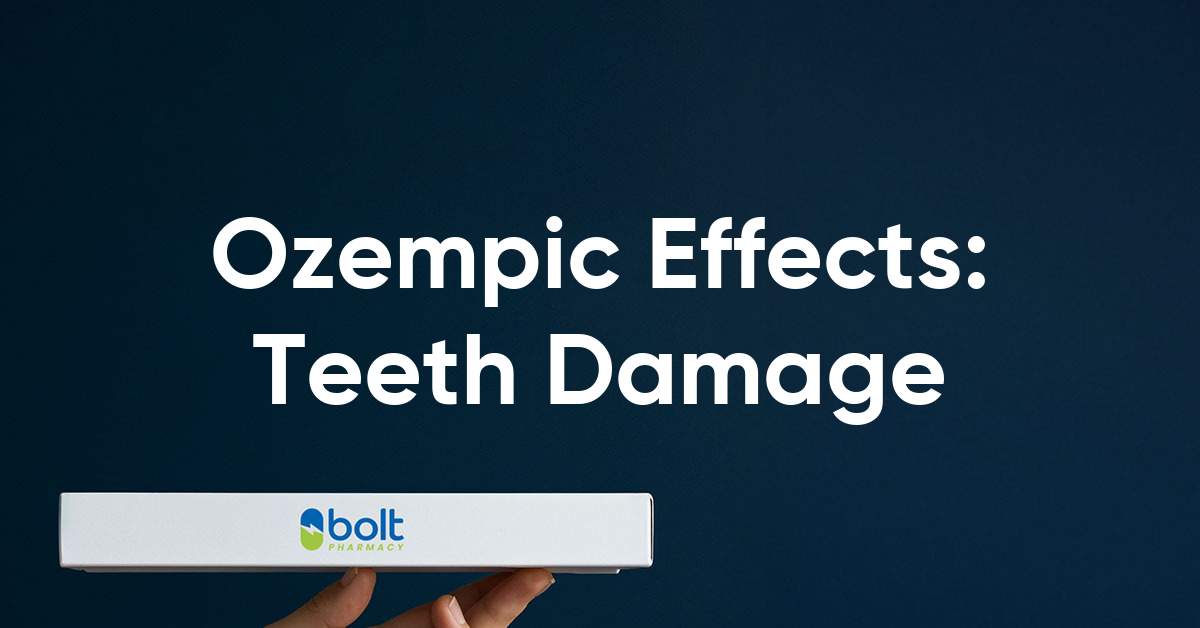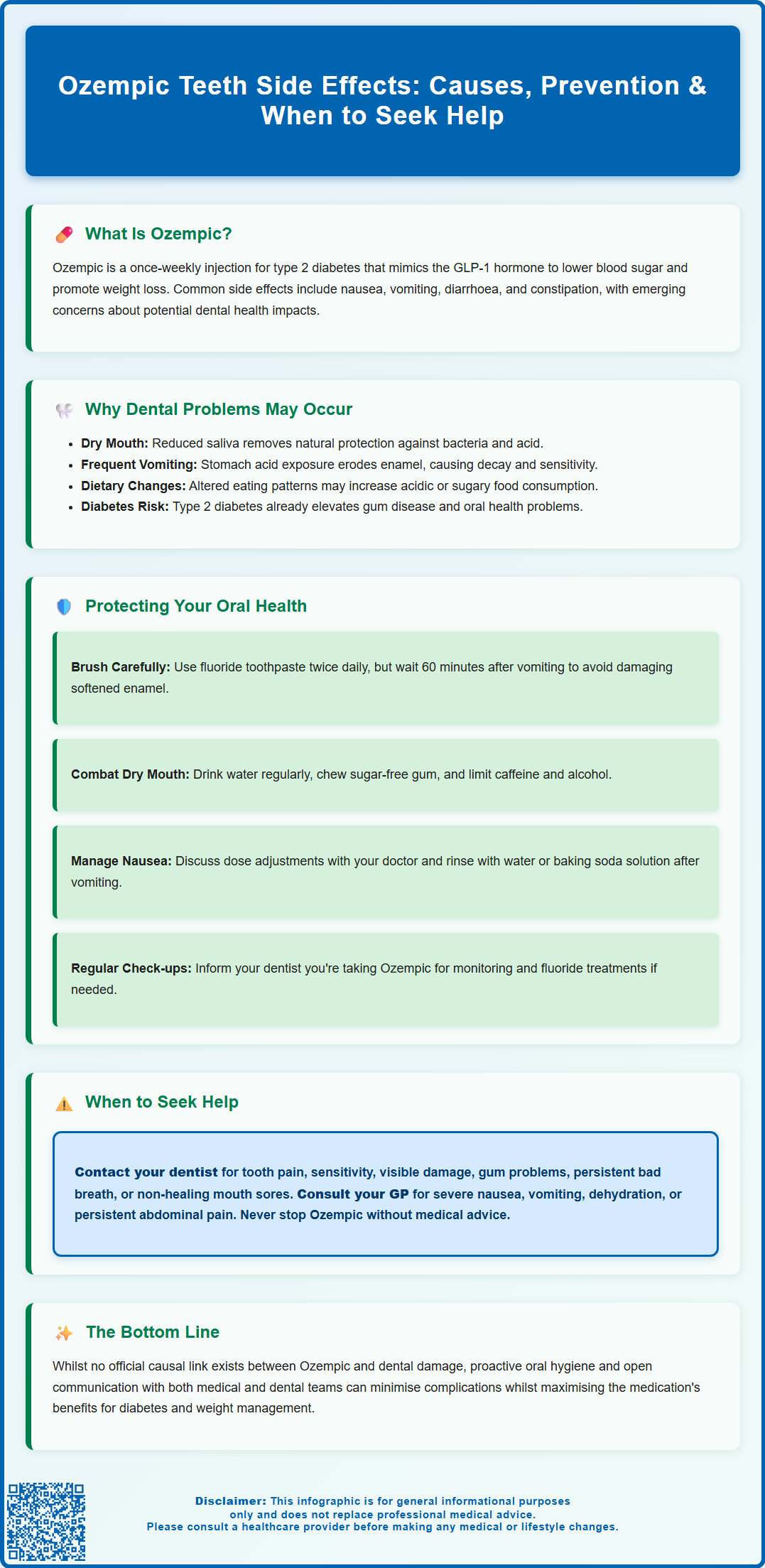Mounjaro®
Dual-agonist support that helps curb appetite, hunger, and cravings to drive substantial, sustained weight loss.
- ~22.5% average body weight loss
- Significant weight reduction
- Improves blood sugar levels
- Clinically proven weight loss

Ozempic (semaglutide) is a GLP-1 receptor agonist licensed in the UK for type 2 diabetes management, administered as a once-weekly injection. Whilst highly effective for glycaemic control and weight loss, some patients have raised concerns about potential effects on oral health. Although dental side effects are not officially listed in the Summary of Product Characteristics, indirect mechanisms—including gastrointestinal symptoms, possible dry mouth, and dietary changes—may theoretically increase the risk of tooth decay, enamel erosion, and gum disease. Understanding these potential pathways and implementing preventive strategies can help protect your dental health whilst benefiting from this medication.
Summary: Ozempic does not directly cause tooth damage, but indirect mechanisms such as gastrointestinal side effects, potential dry mouth, and dietary changes may theoretically increase the risk of dental problems including decay and enamel erosion.
Ozempic (semaglutide) is a prescription medicine licensed in the UK for the treatment of type 2 diabetes mellitus in adults. It belongs to a class of medications known as glucagon-like peptide-1 (GLP-1) receptor agonists. Ozempic is administered as a once-weekly subcutaneous injection and works by mimicking the action of the naturally occurring hormone GLP-1, which plays a crucial role in glucose regulation and appetite control.
The mechanism of action of Ozempic involves several physiological processes:
Enhancing insulin secretion from pancreatic beta cells in a glucose-dependent manner, which helps lower blood sugar levels when they are elevated
Suppressing glucagon release, thereby reducing glucose production by the liver
Slowing gastric emptying, which prolongs the feeling of fullness after meals and contributes to weight loss
Acting on appetite centres in the brain to reduce hunger and food intake
Ozempic has demonstrated significant efficacy in improving glycaemic control and promoting weight loss in clinical trials. The MHRA approved semaglutide for type 2 diabetes management, and NICE guidelines (NG28) recognise GLP-1 receptor agonists as valuable treatment options for patients who have not achieved adequate control with other diabetes medications. A related formulation, Wegovy (also semaglutide but at higher doses), has been licensed specifically for weight management in adults with obesity (NICE TA875).
Whilst Ozempic is generally well-tolerated, like all medications it can cause side effects. According to the Summary of Product Characteristics (SmPC), the most commonly reported adverse effects include gastrointestinal symptoms such as nausea, vomiting, diarrhoea, and constipation. Some patients and healthcare professionals have reported concerns about potential effects on oral health. Understanding these concerns requires examination of both the direct and indirect mechanisms by which GLP-1 medications might influence dental health.

It is important to note that there is no official, established causal link between Ozempic and direct damage to teeth or gums in the product's Summary of Product Characteristics (SmPC) or MHRA safety data. However, several potential indirect mechanisms related to how Ozempic works may theoretically contribute to an increased risk of dental problems, and these warrant careful consideration.
Reduced saliva production and dry mouth (xerostomia) represent one theoretical pathway, although dry mouth is not listed as a common side effect in the Ozempic SmPC. Some patients have anecdotally reported experiencing dry mouth. Saliva plays a vital protective role in oral health by:
Neutralising acids produced by bacteria in the mouth
Washing away food particles and debris
Providing antimicrobial proteins that help control bacterial growth
Facilitating remineralisation of tooth enamel
Reduced salivary flow can increase the risk of dental caries (tooth decay), gum disease, and oral infections.
Gastrointestinal symptoms are directly linked to Ozempic use. According to the SmPC, nausea, vomiting, diarrhoea, and constipation are among the most frequently reported side effects, particularly during the initial weeks of treatment or following dose increases. Repeated exposure of teeth to gastric acid through vomiting can erode tooth enamel, a condition known as dental erosion. This process weakens the protective outer layer of teeth, making them more susceptible to decay, sensitivity, and structural damage.
Dietary changes and nutritional factors may also theoretically play a role. Patients taking Ozempic often experience significant appetite suppression and may alter their eating patterns, sometimes consuming smaller, more frequent meals or snacks. Changes in diet composition, particularly increased consumption of acidic or sugary foods to manage nausea, could contribute to dental problems. The potential impact of rapid weight loss on oral health through nutritional changes remains theoretical and evidence is currently limited.
It is worth noting that people with type 2 diabetes already face an elevated risk of periodontal (gum) disease and other oral health complications due to the effects of elevated blood glucose on immune function and tissue healing, as recognised by NHS guidance. Therefore, any additional factors that compromise oral health in this population deserve attention and proactive management.
Maintaining excellent oral hygiene is essential for all patients taking Ozempic or other GLP-1 receptor agonists. The following evidence-based strategies can help protect your teeth and gums whilst benefiting from this medication:
Establish a rigorous daily oral care routine:
Brush your teeth twice daily with fluoride toothpaste, using a soft-bristled toothbrush and gentle circular motions
Wait at least 60 minutes after vomiting or acid reflux before brushing, as immediate brushing can further damage acid-softened enamel; instead, rinse your mouth with water or a fluoride mouthwash
Floss daily or use interdental brushes to remove plaque and food particles from between teeth
Consider using a fluoride mouthwash to help strengthen enamel; antimicrobial mouthwashes should only be used if specifically recommended by your dentist
Manage gastrointestinal side effects proactively:
If you experience persistent nausea, vomiting, or reflux, discuss this with your GP or diabetes specialist nurse, as adjusting the dose or timing of Ozempic may help
After episodes of vomiting, rinse your mouth thoroughly with water or a bicarbonate solution (one teaspoon of baking soda in a glass of water) to neutralise acid
Avoid lying down immediately after eating, and consider elevating the head of your bed if nighttime reflux is problematic
Stay well-hydrated to support saliva production. Sip water regularly throughout the day, and if you experience dry mouth, consider:
Sugar-free chewing gum or lozenges to stimulate saliva flow
Saliva substitutes or oral moisturising gels available from pharmacies
Limiting caffeine and alcohol, which can worsen dry mouth
Attend regular dental check-ups at intervals recommended by your dentist based on your individual risk factors, as advised in NICE guidance on dental recall. Inform your dental team that you are taking Ozempic so they can monitor for early signs of enamel erosion, decay, or gum disease. Your dentist may recommend:
Professional fluoride treatments to strengthen enamel
Prescription-strength fluoride toothpaste
Dietary advice to minimise acid exposure
Make tooth-friendly dietary choices by limiting acidic foods and beverages (citrus fruits, fizzy drinks, fruit juices) and avoiding frequent snacking on sugary items. When you do consume acidic foods, try to do so as part of a main meal rather than throughout the day, and rinse your mouth with water afterwards, as recommended in the Delivering Better Oral Health toolkit.
Whilst taking Ozempic, it is important to remain vigilant for signs of dental problems and to know when professional assessment is needed. Contact your dentist promptly if you experience:
Tooth pain or sensitivity, particularly to hot, cold, or sweet foods and drinks, which may indicate decay or enamel erosion
Visible changes to your teeth, such as discolouration, chips, cracks, or a worn appearance
Bleeding, swollen, or receding gums, which could signal periodontal disease
Persistent bad breath or an unpleasant taste in your mouth despite good oral hygiene
Loose teeth or changes in your bite
Mouth ulcers or sores that do not heal within 3 weeks (this is a potential sign of oral cancer requiring urgent assessment, according to NICE NG12)
Persistent red or white patches in your mouth
Unexplained lumps in your mouth or neck
Persistent dry mouth that does not improve with self-care measures
Consult your GP or diabetes care team if you experience:
Severe or persistent nausea, vomiting, or reflux that interferes with your quality of life or nutritional intake, as dose adjustment or additional medications may be beneficial
Signs of dehydration, including dark urine, dizziness, or reduced urination
Severe and persistent abdominal pain (with or without vomiting), which could indicate pancreatitis or gallbladder disease – these are rare but serious potential side effects listed in the Ozempic SmPC requiring urgent medical attention
Difficulty swallowing or persistent abdominal pain, which could indicate more serious gastrointestinal complications
Any concerns about the balance between the benefits and side effects of your medication
It is crucial to never stop taking Ozempic without medical advice, as abrupt discontinuation could lead to deterioration in your diabetes control. If side effects are troublesome, your healthcare team can work with you to find solutions, which might include:
Adjusting the dose or rate of dose escalation
Prescribing anti-nausea medications or treatments for reflux
Switching to an alternative diabetes medication if appropriate
For urgent dental problems such as severe tooth pain, dental abscess (swelling with pus), significant trauma to teeth, or uncontrolled bleeding from the gums, seek same-day dental care. Many dental practices offer emergency appointments, or you can contact NHS 111 for guidance on accessing urgent dental services in your area.
Patient safety is paramount. By maintaining open communication with both your medical and dental teams, practising excellent oral hygiene, and seeking timely advice when concerns arise, you can minimise the risk of dental complications whilst benefiting from Ozempic's therapeutic effects on diabetes management and weight control. Remember that prevention is always better than treatment when it comes to oral health, and the strategies outlined in this article can help protect your teeth and gums throughout your treatment journey.
No, there is no official causal link between Ozempic and direct tooth damage in MHRA safety data or the Summary of Product Characteristics. However, indirect mechanisms such as gastrointestinal side effects (vomiting exposing teeth to gastric acid) and potential dry mouth may theoretically increase the risk of dental problems.
Brush twice daily with fluoride toothpaste, floss regularly, wait 60 minutes after vomiting before brushing, rinse your mouth with water or bicarbonate solution after acid exposure, stay well-hydrated, attend regular dental check-ups, and inform your dentist that you are taking Ozempic.
Contact your dentist promptly if you experience tooth pain or sensitivity, visible changes to teeth (discolouration, chips, wear), bleeding or swollen gums, persistent bad breath, loose teeth, mouth ulcers lasting over 3 weeks, or persistent dry mouth despite self-care measures.
The health-related content published on this site is based on credible scientific sources and is periodically reviewed to ensure accuracy and relevance. Although we aim to reflect the most current medical knowledge, the material is meant for general education and awareness only.
The information on this site is not a substitute for professional medical advice. For any health concerns, please speak with a qualified medical professional. By using this information, you acknowledge responsibility for any decisions made and understand we are not liable for any consequences that may result.
Lorem ipsum dolor sit amet, consectetur adipiscing elit, sed do eiusmod tempor incididunt ut labore et dolore magna aliqua. Ut enim ad minim veniam, quis nostrud exercitation ullamco laboris nisi ut aliquip ex ea commodo consequat. Duis aute irure dolor in reprehenderit in voluptate velit esse cillum dolore eu fugiat nulla pariatur.
Block quote
Ordered list
Unordered list
Bold text
Emphasis
Superscript
Subscript